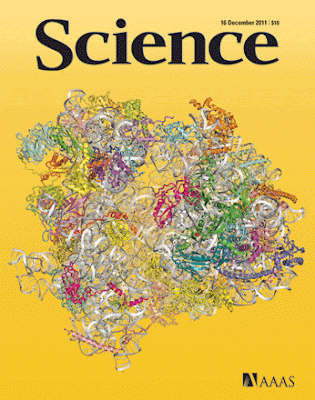There's a picture of a yeast (Saccharomyces cerevisiae) ribosome on the cover of the Dec. 16, 2011 issue of Science. The paper inside by Ben-Sham et al. (2011) describes the structure at 3Å resolution.
There's nothing revolutionary here but I thought I would show you the structure just to emphasize a particular point. You can see the same image below without the distracting orange background.
Most of the ribosome is composed of RNA (silver-gray strands). You can see that a lot of this single-stranded RNA forms short double-helical regions when the RNA folds back on itself. Small ribosomal proteins (various colors) decorate the surface of the ribosome by binding to specific regions of the ribosomal RNA.
The overall impression is that the ribosome is a big ball of RNA with a small amount of protein. The actual site of translation, where messenger RNA is translated into a polypeptide, takes place in the middle of the ribosome near the hole you see in this structure. Translation is catalzyed by the RNA component of the ribosome, not by the ribosomal proteins.
I don't know about the rest of you but I grew up with an electron-micrographic image of a ribosome in my head and I just assumed that what I was seeing was a large glob of protein. If course I realized that there was a huge amount or RNA in there somewhere but I didn't think it contributed very much to the dark blobs in the cell.
When the first crystal structures of ribosomes were published I had to stare at them for quite some time in order to purge the old images from my mind and adopt a new perspective.
Eukaryotes have 79 ribosomal proteins and prokaryotic ribosomes have only 52 proteins. There are prokaryotic ribosomal proteins that have no homoogues in eukaryotes and 33 of the eukaryotic ribosomal proteins have no homologues in bacteria—they are eukaryotic specific. Furthermore, many of the eukaryotic proteins differ considerably from their bacterial homologues. (Mostly by extensions of the poly peptide chain.)
The protein components of ribosomes are not highly conserved. One gets the impression that they don't contribute much to the function of a ribosome—an impression confirmed by the fact that the RNA by itself can catalyze polypeptide synthesis. They may help stabilize the three-dimensional structure of the ribosome.
[Image credit: The bottom image is "courtesy of Prof Marat Yusupov (IGBMC, Strasbourg)" from The 9th international Conference on Ribosome Synthesis that takes place this summer in Banff, Alberta, Canada.]
Ben-Shem A, Garreau de Loubresse N, Melnikov S, Jenner L, Yusupova G, Yusupov M. (2011) The structure of the eukaryotic ribosome at 3.0 Å resolution. Science 334:1524-1529. (Epub 2011 Nov 17). [doi: 10.1126/science.1212642]









